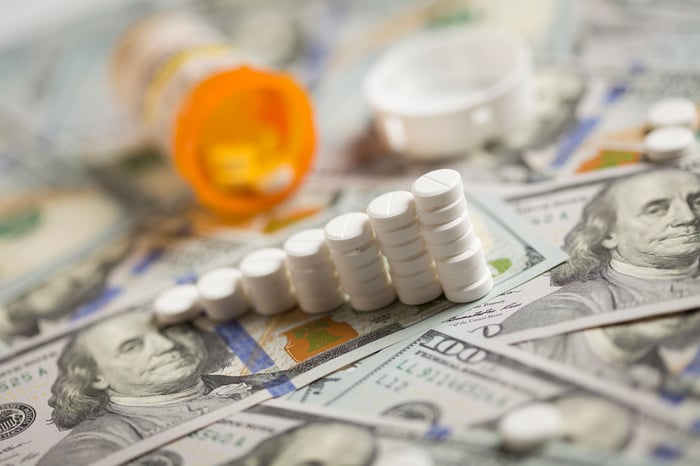GlaxoSmithKline (GSK 0.20%) has popped up on plenty of radar screens following some bold, unexpected moves. Investors will finally get the consumer healthcare spinoff they've been asking for through a recently formed joint venture with Pfizer (PFE -3.35%). The British pharma giant also dived back into the lucrative oncology space with a $5 billion biotech acquisition in early December.
Although Glaxo's taken some important steps toward building a product lineup full of new blockbuster drugs, it isn't there yet. While some eyes were on Glaxo, Eli Lilly (LLY -1.00%) has successfully assembled one of the most impressive new-product lineups in the business.

Image source: Getty Images.
Here's what you need to know about Eli Lilly and the growth drivers that could help it achieve rapid sales growth.
9 big drug launches in just 5 years
In five short years, Eli Lilly has launched nine new drugs with blockbuster potential, some of which already add more than $1 billion annually to total revenue. Trulicity is a weekly injection for type-2 diabetes that racked up $2.3 billion during the first nine months of 2018, a 65% gain versus the prior-year period. The Centers for Disease Control and Prevention (CDC) thinks there are around 29 million type-2 diabetics in the U.S. alone, which means Trulicity sales could climb much further.
Taltz is a psoriasis treatment that grew sales a stunning 74% in the third quarter, achieving an annualized run rate of $1.1 billion. That's impressive for a treatment that launched a couple of years ago into a competitive market. Recent psoriatic arthritis results that significantly outperformed the megablockbuster Humira could help Taltz sales continue rocketing.

Image source: Getty Images.
Headache relief
In September, the Food and Drug Administration approved Emgality to help prevent migraine headaches for an enormous group of patients -- those who suffer from regular migraines. Emgality is one of three new monthly injections proven to reduce migraine frequency, and they all work essentially the same way.
In 2019, investors will want to keep an eye on total prescriptions compared with Aimovig from Amgen (AMGN -0.93%) and Ajovy from Teva Pharmaceuticals (TEVA 1.50%). Lilly and its peers are currently offering deep discounts to spark awareness of their new treatment options and gain a leading share of this potentially lucrative market. With an estimated 30 million migraine sufferers in the U.S. alone, analysts will be shocked if annual Emgality sales don't pass the $1 billion mark by 2022.
Although Eli Lilly will compete with Teva Pharmaceuticals and Amgen for migraine patients seeking preventive therapy, Lilly could sew up the market for acute relief with lasmiditan. If the FDA approves an application Lilly submitted in November, lasmiditan could become the first new acute treatment for migraines in decades. During a study underpinning lasmiditan's application, patients were 110% more likely to report feeling headache-free two hours after taking the experimental pain reliever than patients given a placebo.

Image source: Getty Images.
A cancer drug relaunch to watch
Eli Lilly launched a new breast cancer tablet called Verzenio in late 2017 that didn't begin gaining traction until the FDA expanded its addressable-patient population to include newly diagnosed breast cancer patients in February 2018. Verzenio is similar to Ibrance, a blockbuster Pfizer launched in 2015 that racked up an astounding $3 billion in sales during the first nine months of 2018.
During a clinical trial that supported Ibrance's approval for newly diagnosed patients, adding the capsules to standard care reduced their risk of disease progression or death by 42.4%, compared with standard treatment on its own. Eli Lilly hasn't tested Verzenio head-to-head against Ibrance, so comparisons need to be taken with a grain of salt. In a similar study, adding Verzenio to standard care led to a slightly better than 46% reduction in patients' risk of disease progression or death.
A majority of patients given Verzenio still hadn't shown signs of disease progression 28.2 months after starting treatment, and long treatment durations could drive sales to similar heights as Ibrance in the years ahead.

Image source: Getty Images.
The attraction in the numbers
GlaxoSmithKline shareholders have suffered a declining dividend for years, but Eli Lilly has raised its payout every year since 2014. Lilly shares offer a decent 2.3% yield at recent prices following a big 15% payout bump that the company committed to in December.
At recent prices, investors can scoop up shares of Lilly for just 18.3 times management's earnings estimates for 2019. At the moment, the average stock in the S&P 500 trades at 15.1 times forward estimates, but Lilly's growth story will probably be far more exciting than most stocks in the benchmark index. The average Wall Street analyst following Lilly expects its bottom line to grow by 13.9% annually over the next five years.
Verzenio's success in a space dominated by Ibrance isn't certain, and blockbuster migraine sales could fail to materialize. But at recent share prices, those look like risks well worth taking.





